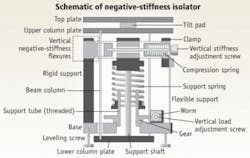Professor Jian-Young Wu has been conducting research on waves of neuronal activity in the neocortex of the brain. Wu and his colleagues at the Department of Physiology and Biophysics at Georgetown University Medical Center visualize wave-like patterns in the brain cortex using optical imaging and voltage-sensitive dye—a method that depends on robust vibration isolation. Their neuronal specimens are derived from slices of rat neocortex, the outer layer of a mammal’s brain, which is involved in higher functions such as sensory perception and generation of motor commands and, in humans, language.
The neurons of the neocortex are arranged in vertical structures called neocortical columns that measure about 0.5 mm in diameter and 2 mm in depth. Each column typically responds to a sensory stimulus representing a certain body part, or region of sound or vision. In the human neocortex, it is postulated that there are about a half-million of these columns, each of which contains approximately 60,000 neurons.
The neocortex can be viewed as a huge web, consisting of billions to trillions of neurons and hundred of trillions of interconnections. While individual neurons are too simple to have intelligence, the collective behavior of the billions of interneuronal interactions occurring each second can be highly intelligent.
Brain activity investigation
Traditionally, scientists have studied brain activity by placing a few electrodes in the brain and measuring the electrical signals of the neurons close to the electrodes. This method is workable for understanding the function of the cortex and interactions between individual neurons, but it is not suitable for studying the emerging properties of the nervous system.
“It is like viewing a few pixels on a television screen and trying to figure out the story,” explains Dr. Wu. “Now, with optical methods and voltage-sensitive dyes, we can visualize the activation in a large area of the neocortex when the brain is processing sensory information, similar to watching the whole television screen.”
“Voltage-sensitive dye is a compound that stains neuronal membrane and changes its color when the neuron is excited,” continues Dr. Wu. “This allows us to visualize population neuronal activity dynamically in the cortex. We study how individual neurons in the neocortex interact to generate population neuronal activities that underlie sensory and motor processing functions. Population activities are composed of the coordinated activity of up to billions of neurons. Currently, we study how oscillations and propagating waves can be generated by small ensembles of neocortical neurons.”
Viewing the spatiotemporal patterns of neuronal population in the cortex is markedly different from recording individual neurons. Here the cortical activity is viewed as “population activity” that can be more complex than the linear addition of an individual neuron’s activity. Voltage-sensitive dye and optical recording techniques give the neuroscientist a new tool for figuring out how the brain cortex works (see Fig. 1).
Spirals highlight cardiac fibrillation, epilepsy
Wu’s imaging team has uncovered spiraling wave patterns resembling little hurricanes in the brain. He believes that this hurricane-like spiral pattern is an emergent behavior of the network. “A metrological hurricane is an emergent behavior of a large volume of air molecules,” says Wu. “If you were to dissect a hurricane into individual air molecules you would not find any special process that generates a hurricane. Similarly, in the nervous system, spiral waves are an emergent process of the neuronal population and there might be no special cellular process attributed to spirals.” But like a hurricane, spiral waves can be a powerful force for organizing the activity of a neuronal population. Spirals generated in a small area can send out a powerful storm that invades large, normal brain areas and starts a seizure attack. This hypothesis would mean that epilepsy could be viewed not just as mis-wiring in the brain, but as an abnormal wave pattern that invades normal tissue.
Similarly, during cardiac fibrillation, spiral waves form in the heart emitting rotating and scroll waves in two and three dimensions. As a leading life-threatening situation, these rotating waves can kill the patient instantly as the pumping function of the heart is disrupted by the 5 to 10Hz rotations that drive chaotic and abnormally rapid cardiac contractions.
Wu believes that propagating waves are a basic pattern of cortical neuronal activity, and that these wave patterns may play an important role in initiating and organizing brain activity involving millions to billions of neurons. Studying the spatiotemporal patterns of neuronal population activity may provide insight into normal brain functions and pathological disorders. This research has the potential to help scientists understand abnormal waves that are generated in the brains of patients with epilepsy.
Vibration isolation
Because voltage-sensitive dye signals are small, usually a change of 0.1 to 1.0 percent of the illumination intensity, Wu’s team has used a high-dynamic-range camera, photodiode array to detect the voltage-sensitive dye signals of the cortical activity. The photodiode array can resolve extremely small changes in light, usually one part of ten thousands. (Human eyes and ordinary digital cameras register light changes of one part to a hundred). Detecting such small signals requires a high level of vibration isolation. The lab had to contend with low frequency vibrations from air conditioning equipment, people walking, and wind blowing against the building. Vibrations as low as 1Hz were inhibiting the integrity of the images and data.
“At first, we used high-quality air tables, but they were not adequate for isolating low frequency vibrations,” Dr. Wu continues. “We tried putting a second air table on top of the first one, but that still did not give us the isolation we needed. Then we tried an active, electronic system, but we were still spending much time fighting with floor vibrations. We were dealing with an unresolved vibration problem for many years.”
The Georgetown lab eventually tested, and settled upon negative-stiffness mechanism systems from Minus K Technology (Inglewood, CA; www.minusk.com), which reduced vibration isolation to 1Hz and cancelled out noise difficulties that were inhibiting image and data readings (see Fig. 2). Negative-stiffness mechanism (NSM) isolators have the flexibility of custom tailoring resonant frequencies vertically and horizontally. Vertical-motion isolation is provided by a stiff spring that supports a weight load, combined with a NSM. The net vertical stiffness is made very low without affecting the static load-supporting capability of the spring. Beam-columns connected in series with the vertical-motion isolator provide horizontal-motion isolation. The horizontal stiffness of the beam-columns is reduced by the “beam-column” effect. A beam-column behaves as a spring combined with a NSM.NSM also offers substantial transmissibility improvement over air systems (whose resonant frequency can match that of floor vibrations and actually worsen problems) and over active systems (which have a limited dynamic range and are vulnerable to electronic dysfunction and power modulations). Although active isolation systems have fundamentally no resonance, their transmissibility does not roll off as fast as negative-stiffness isolators. Transmissibility is a measure of the vibrations that transmit through the isolator relative to the input vibrations. The NSM isolators, when adjusted to 0.5Hz, achieve 93 percent isolation efficiency at 2Hz; 99 percent at 5Hz; and 99.7 percent at 10Hz.
Continuing research
Within the past ten years, Wu’s team has documented a variety of waveforms (e.g., plane wave and spirals) in brain slices during artificially induced oscillations. Using neocortical slices and mathematic models, they are studying the initiation of the waves and the factors that control their propagating direction and velocity.
The lab is also involved in the development of new optical imaging techniques (also dependent on vibration isolation) such as imaging propagating waves in vivo, in intact brains. “This is technically difficult,” says Wu. “Other imaging methods (MRI, PET, or MEG) provide inadequate spatiotemporal resolution. Large scale neuronal activity is a hallmark of a living brain. We are improving the optical imaging techniques with a hope to visualize the waves in the cortex in vivo during sensory processes and in awake animals while behavioral and cognitive tasks are performed.”
(For more information, contact Jian-Young Wu, professor, Department of Physiology and Biophysics, at Georgetown University Medical Center, www.georgetown.edu/faculty/wuj/[email protected].)
About the Author
Jim McMahon
CEO, ZebraCom
Jim McMahon is CEO of ZebraCom (Simi Valley, CA), a public relations firm for industrial and high-tech companies.

